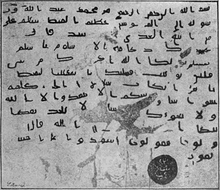Seal of Muhammad
The seal of Muhammad (Turkish Mühr-i Saâdet ) is an Islamic relic . It is the seal stone of a ring. The stone consists of rectangular and approx. 1 cm long red agate , on which is written “ Mohammed , Prophet of God” in Kufic script . The associated ring has not been preserved. The relic was in Baghdad in the 19th century and was brought to Istanbul by the Ottomans. Even according to Islamic tradition, it is not the original seal of Muhammad, since the caliph ʿUthmān accordingly dropped the seal into a well.
Georg Wilhelm Freytag describes this incident as follows:
-
In the seventh year of his escape, Muhammad got himself a silver signet ring, on which the words Arabic محمد رسول الله"Moḥammed the Messenger of God", in three lines, so that each word was one line, were engraved. His next successors inherited this. The Khalif ʿOṯmân still used him. but in the year 30 it fell from his hand into the well of Arîs in Medînah and was not found again. Another was imitated, and the following chaliphs made use of it.
The seal stone belongs to the Emanat-ı mukaddese and is kept in the Topkapı Palace and there in the Mukaddes Emanetler Dairesi . He is registered there under the number 21/167.
On the alleged letter of Muhammad to al-Muqauqis, the parchment bears a round seal of Muhammad. The parchment is most likely a forgery.
Individual evidence
- ^ Journal of the German Oriental Society , Vol. 10 (1856). History of the Hamdanid dynasties in Mosul and Aleppo [1]
- ^ The Encyclopaedia of Islam. New Edition, sv Al-Mukawkis
literature
Nebi Bozkurt, Türkiye Diyanet Vakfı İslâm Ansiklopedisi, sv Mukaddes Emanetler.
